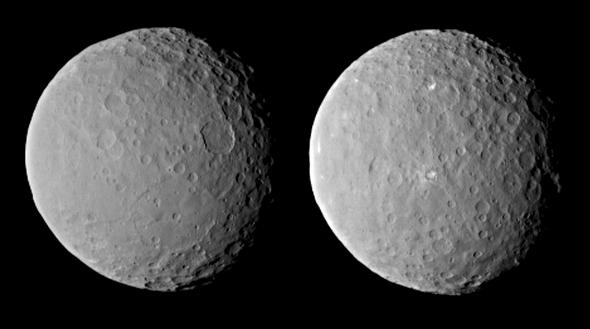Dawn approaches Ceres.
The spacecraft Dawn, that is, and the asteroid Ceres, the largest of the rocks orbiting the Sun between Mars and Jupiter. Dawn has been headed slowly toward Ceres for many months now, and only recently has its target been big enough to see as more than a dot.
On Feb. 19, 2015, Dawn took the image of Ceres above from a distance of 46,000 kilometers (29,000 miles; roughly an eighth the distance of the Moon from the Earth). Earlier pictures already revealed a bright spot on the surface, and now the resolution is good enough to see it’s not one spot, but two. Like a distant car on the highway getting near, and seeing its headlights split from one bright glare to two, Dawn’s proximity to Ceres has allowed us to see the shiny spot is not alone.

Photo by NASA/JPL-Caltech/UCLA/MPS/DLR/IDA
It’s still too early to say what we’re seeing here. Ceres has a lot of water ice inside it, and it seems likely these spots are related to that. You can also see they’re located in a crater—which isn’t necessarily remarkable; as you can see the whole surface of Ceres is saturated with them. My initial thought was that an impact had revealed ice underneath the surface, digging it up. We see that in some craters on Mars, for example.
But now I wonder. It’s possible that we’re seeing cryovolcanism: literally, ice volcanoes. But it’s hard to understand what would drive that. Ceres is too small to have tectonics and has no moon that might generate tides to warm the interior.
At the moment, it’s a mystery. And that’s good! We’ve never seen Ceres in this detail before, so everything we learn about it will be new.
For example, look at the large craters on it. They look to me to be flatter than craters that size would be on other worlds. I suspect we’re seeing either a softer surface, or that ancient, big impacts melted ice under the craters which flooded the floors. We see similar things on the Moon, but in that case it was molten rock, not water, that filled the floors.
But I’m speculating, based on what we see so far. And these are still relatively low resolution images; compare them with what we saw when Dawn orbited Vesta, its first asteroid target, to get a taste of what’s coming. Dawn will enter orbit around Ceres on March 6, and will continue to orbit the asteroid for well over a year. What mysteries will it unveil that we haven’t even guessed at yet?
